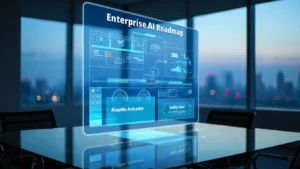AI for Logistics Workforce Planning and Optimization
It is no secret that effective workforce planning and optimization are pivotal for seamless operations in logistics. However, the intricacies of modern supply chains demand more than traditional approaches can offer. This is where AI steps in as a transformative force. In this introductory blog, we will delve into the realm of AI-driven workforce planning and optimization in logistics.
From predictive analytics forecasting demand to intelligent scheduling that adapts to real-time changes, we’ll explore how AI solutions revolutionize these fundamental aspects of logistics management. Join us as we uncover the potential of AI to enhance efficiency, reduce costs, and propel logistics businesses toward greater success in today’s competitive landscape.
Challenges in Traditional Logistics Workforce Planning
In traditional logistics workforce planning, companies often face a myriad of challenges that hinder efficiency and productivity. Let’s delve into some of these challenges and understand why they pose significant obstacles:
Manual Processes
Many logistics companies still rely on manual methods for workforce planning, such as spreadsheets or paper-based systems. This approach is time-consuming, prone to errors, and lacks the agility needed to adapt to dynamic operational demands. Without automation, managers spend valuable time on administrative tasks rather than strategic decision-making.
Limited Data Visibility
Traditional workforce planning systems often lack real-time data visibility across the entire logistics network. This limited access to data makes it difficult for managers to gain insights into workforce performance, resource utilization, and demand fluctuations. Without accurate and up-to-date information, companies struggle to make informed decisions and optimize their workforce effectively.
Forecasting Accuracy
Forecasting demand and staffing requirements is inherently challenging in the logistics industry due to its dynamic nature. Traditional forecasting methods often rely on historical data and simplistic models, which may fail to capture complex factors such as seasonality, market trends, or sudden changes in demand. As a result, companies may overstaff or understaff, leading to inefficiencies and increased labor costs.
Skill Gaps and Talent Shortages
Recruiting and retaining skilled workers in the logistics sector can be a significant challenge. The industry faces ongoing shortages of qualified personnel, particularly in specialized roles such as truck drivers, warehouse supervisors, and logistics analysts. Moreover, identifying and addressing skill gaps within the workforce requires proactive planning and investment in training programs, which may be overlooked in traditional workforce planning processes.
Inflexible Scheduling
Traditional scheduling methods often lack flexibility to accommodate changing business needs and employee preferences. Fixed shift schedules may result in underutilized resources during off-peak hours or lead to employee dissatisfaction due to inflexible working arrangements. Additionally, manually adjusting schedules to account for unforeseen events or disruptions can be cumbersome and time-consuming, impacting operational efficiency.
Ineffective Communication
Poor communication between different departments or locations within the logistics organization can hinder workforce planning efforts. Siloed information and disjointed communication channels may result in misalignment between workforce plans and actual operational needs. Without seamless coordination and collaboration, companies struggle to optimize resource allocation and respond effectively to evolving business requirements.
AI Applications in Logistics Workforce Planning and Optimization
AI is revolutionizing logistics workforce planning and optimization by providing advanced tools and techniques to address the complexities and challenges inherent in the industry. Let’s explore in-depth how AI applications are transforming workforce management in logistics:
Predictive Analytics
Predictive analytics is like having a crystal ball for your logistics operations. It’s all about using AI-powered tools to sift through mountains of historical data and real-time information, then crunching the numbers to predict what’s going to happen in the future.
Imagine this: you’re a logistics manager overseeing a warehouse. With predictive analytics, you can look at past customer orders, inventory levels, and transportation schedules to see patterns emerge. Maybe you notice that every summer, there’s a spike in orders for a particular product. Or perhaps you see that certain times of the day tend to be busier than others.
By analyzing these trends, AI can forecast future demand with remarkable accuracy. It can predict how many workers you’ll need on the floor during peak hours, or when you might need to ramp up inventory to meet a surge in orders.
Intelligent Scheduling
Intelligent scheduling in logistics is a game-changer, thanks to AI algorithms that work tirelessly to optimize every aspect of your operations. These algorithms take into account a multitude of factors, including workforce availability, skill levels, and operational constraints, to create optimal schedules. With intelligent scheduling, AI can analyze real-time traffic data to find the quickest routes for each delivery, minimizing fuel costs and maximizing efficiency. At the same time, it considers the availability of your drivers, their skill levels, and any regulatory requirements for rest breaks.
AI-driven scheduling systems can adapt on the fly. If there’s a sudden surge in demand or a last-minute change in your workforce availability, the algorithms can quickly adjust the schedule to accommodate. It’s like having a team of super-smart planners working behind the scenes, constantly optimizing your operations to run smoother and faster.
Skills Matching and Training
Skills matching and training in logistics are undergoing a profound transformation, thanks to the power of AI. Let’s explore how AI is revolutionizing the way companies manage their workforce:
Skill Matching
AI algorithms analyze a wealth of data, including employee skills, experience, and performance metrics, to match workers with tasks or roles that align with their capabilities. By understanding each employee’s strengths and weaknesses, AI can ensure that the right person is assigned to the right job, optimizing efficiency and productivity. For example, a worker with strong organizational skills may be better suited for inventory management tasks, while someone with excellent communication skills could excel in customer service roles.
Identifying Skill Gaps
AI-driven systems can pinpoint skill gaps within the workforce by comparing employees’ current skills against the requirements of their roles or potential future positions. By identifying areas where additional training or development is needed, companies can take proactive steps to address these gaps and ensure that their workforce remains competitive and adaptable in a rapidly changing industry.
Targeted Training Programs
Armed with insights from AI analysis, companies can develop targeted training programs that address specific skill gaps and development needs within the workforce. AI-powered training platforms use personalized learning algorithms to deliver tailored content to individual employees, ensuring that training is relevant, engaging, and effective. For example, an employee who needs to improve their knowledge of warehouse safety protocols may receive targeted modules on this topic, while another employee focused on improving their technical skills may receive different training materials.
Maximizing Effectiveness and Engagement
AI-driven training platforms go beyond one-size-fits-all approaches by delivering personalized learning experiences that cater to each employee’s unique learning style, preferences, and pace. By offering interactive exercises, simulations, and real-world scenarios, AI-powered training programs keep employees engaged and motivated to learn. Additionally, AI algorithms continuously track employee progress and performance, providing feedback and recommendations for further improvement. This guarantees that training efforts are maximized, and employees are equipped with the skills and knowledge they need to excel in their roles.
Real-Time Monitoring and Adaptation
AI systems continuously monitor workforce performance, operational metrics, and external factors in real time to identify opportunities for optimization and improvement. By analyzing data from sensors, IoT devices, and other sources, AI can detect anomalies, predict potential issues, and recommend proactive interventions to mitigate risks or capitalize on opportunities. These real-time insights enable logistics companies to adapt quickly to changing conditions, minimize disruptions, and maintain efficiency and service quality.
Collaborative Robotics (Cobots)
AI-powered collaborative robots, or cobots, work alongside human workers to automate repetitive tasks, streamline processes, and enhance productivity in logistics operations. These intelligent robots use AI algorithms to learn from human behavior, adapt to dynamic environments, and perform tasks with precision and efficiency. By automating manual labor tasks such as picking, packing, and sorting, cobots free human workers to focus on higher-value activities, improving overall workforce productivity and job satisfaction.
Demand Forecasting and Capacity Planning
Real-time monitoring and adaptation is like having a set of vigilant eyes and quick reflexes overseeing your logistics operations, thanks to AI. Let’s delve into how this powerful technology is transforming the way companies manage their workforce in real-time:
Continuous Monitoring
AI systems are constantly at work, keeping a watchful eye on various aspects of workforce performance and operational metrics. Using data from sensors, IoT devices, and other sources, AI algorithms analyze information in real-time to detect any anomalies or deviations from expected norms. Whether it’s monitoring employee productivity, equipment performance, or inventory levels, AI ensures that nothing escapes its scrutiny.
Identifying Opportunities and Risks
By analyzing real-time data streams, AI can identify opportunities for optimization and improvement, as well as potential risks or issues that may arise. For example, AI may detect a sudden increase in demand for a particular product, prompting the need for additional workforce allocation or inventory replenishment. Conversely, it may identify a bottleneck in the supply chain or a malfunctioning piece of equipment that requires immediate attention.
Proactive Intervention
Armed with real-time insights, AI can recommend proactive interventions to mitigate risks or capitalize on opportunities. For instance, if AI detects a potential equipment failure, it can alert maintenance staff to perform preventive maintenance before the issue escalates into a full-blown breakdown. Similarly, if AI anticipates a surge in demand during a peak season, it can suggest adjustments to workforce scheduling or inventory management to ensure smooth operations and customer satisfaction.
Adapting Quickly to Changing Conditions
The beauty of AI lies in its ability to adapt quickly to changing conditions. Whether it’s responding to fluctuations in demand, adjusting workforce allocation, or rerouting shipments in response to traffic congestion, AI-driven systems can make split-second decisions to keep operations running smoothly. By dynamically adjusting strategies and tactics in real-time, logistics companies can minimize disruptions, maximize efficiency, and maintain high levels of service quality even in the face of unforeseen challenges.
Benefits of AI in Logistics Workforce Planning and Optimization
The benefits of implementing AI in logistics workforce planning and optimization are profound and far-reaching, offering companies a competitive edge and enabling them to thrive in today’s rapidly evolving business landscape. Here’s a detailed exploration of the key advantages:
Increased Efficiency and Productivity
AI-driven workforce planning and optimization streamline processes, reduce manual labor, and eliminate inefficiencies, resulting in increased efficiency and productivity. By automating repetitive tasks, such as scheduling and route planning, AI frees up valuable time for employees to focus on more strategic activities, driving overall productivity gains across the organization.
Cost Reduction and Resource Optimization
By accurately forecasting demand, optimizing resource allocation, and minimizing operational downtime, AI helps logistics companies reduce costs and maximize resource utilization. AI-driven scheduling and routing algorithms can minimize fuel consumption, reduce labor costs, and optimize vehicle fleet usage, resulting in significant cost savings over time.
Enhanced Flexibility and Adaptability
AI-powered workforce planning systems enable logistics companies to adapt quickly to changing market conditions, customer demands, and operational requirements. By dynamically adjusting schedules, reallocating resources, and responding in real-time to disruptions or unexpected events, AI enhances operational flexibility and agility, allowing companies to stay ahead of the curve and maintain a competitive edge.
Improved Customer Service and Satisfaction
By optimizing workforce planning and resource allocation, AI ensures that logistics companies can meet customer demands effectively and deliver exceptional service levels. AI-driven scheduling algorithms can optimize delivery routes, minimize delivery times, and ensure on-time deliveries, resulting in improved customer satisfaction and loyalty.
Better Decision-Making and Strategic Planning
AI provides logistics companies with valuable insights and actionable intelligence, enabling data-driven decision-making and strategic planning. By analyzing vast amounts of data, identifying trends, and predicting future outcomes, AI helps companies make informed decisions that drive business growth and competitive advantage.
Proactive Risk Management and Mitigation
AI-powered predictive analytics and real-time monitoring enable logistics companies to identify potential risks, anticipate disruptions, and implement proactive mitigation strategies. By detecting anomalies, predicting equipment failures, and recommending preventive maintenance actions, AI helps companies minimize operational risks and maintain high levels of service reliability and quality.
Wrapping Up
It’s clear that AI has revolutionized how logistics companies approach workforce planning and optimization. By leveraging AI-powered tools and algorithms, these companies can now navigate complex challenges with unprecedented ease and precision.
Looking ahead, the potential of AI in logistics workforce planning and optimization is immense. As technology continues to evolve, so too will the opportunities to further enhance operations and drive even greater success.
Unlock the potential of AI in your logistics operations with RTS Labs. Our expert team specializes in AI consulting and can tailor solutions to optimize your workforce planning and streamline operations. Ready to transform your logistics?






